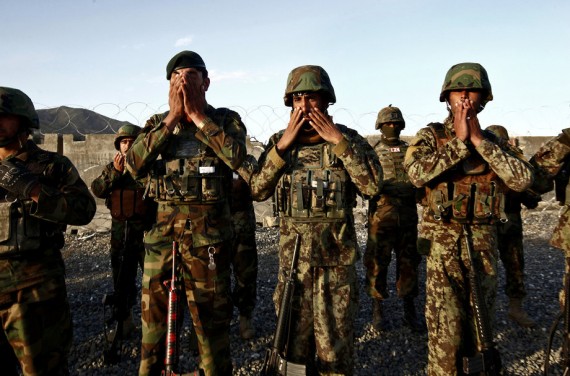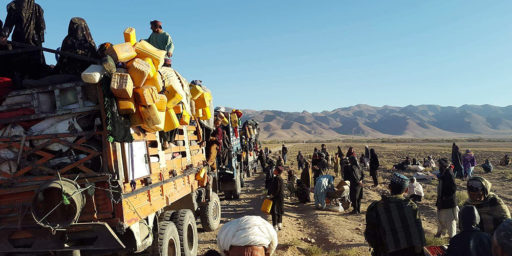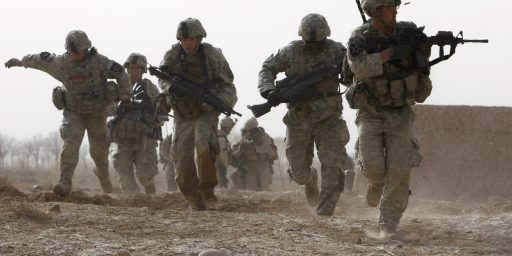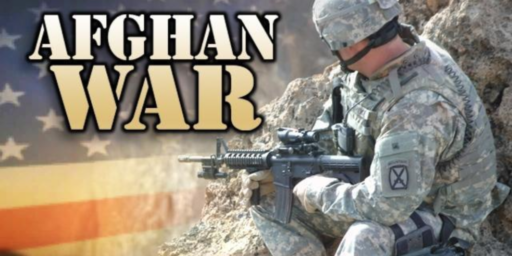Afghan Troops Can’t Maintain Humvees, Either
On the eve of transition to solo operations, Afghan forces can't do basic logistical functions.
On the eve of transition to solo operations, Afghan forces can’t do basic logistical functions.
LA Times (“Transition from U.S. to Afghanistan military an uphill climb“):
Congress has appropriated $51 billion to build and sustain the Afghan army, but Lt. Col. Kohadamani Hamidullah can’t get his Humvees repaired.
“See all those Humvees?” he said inside his military base here in east-central Afghanistan, pointing to a ragged line of dusty Humvees. “Broken. Broken. Broken…. All broken.”
The United States has supplied 46 Humvees for Hamidullah’s battalion here in the rugged, snowcapped peaks of Wardak province in the last couple of years. Only 16 are still running.
A shortage of spare parts, plus a lack of trained mechanics, is among Hamidullah’s headaches as he struggles to wean his troops from dependence on the U.S. military. American combat forces are scheduled to leave next year, and the White House is reportedly considering pulling the rest as well. Last month marked the formal transfer of security responsibilities from international troops to Afghan forces. As a consequence, the colonel and his U.S. counterpart are hustling to forge a self-sufficient national fighting force.
Hamidullah, 38, already plans 90% of his unit’s operations against the Taliban in the villages and farm fields of this strategic province on Kabul’s southwestern shoulder. But U.S. Army Lt. Col. Curby Scarborough, a tall, rangy artillery officer, continues to huddle with Hamidullah almost daily. He and other U.S. advisors mentor Hamidullah’s several hundred troops in a province where Taliban fighters dominate the countryside outside Maidan Shahr, the provincial capital.
U.S. infantrymen have rushed to aid Afghan troops confronted by Taliban fighters.
The U.S. has sent attack planes and helicopters to assist Afghan forces and has helped with medical evacuation. That help is all but ending with the transfer to full Afghan security control.
Scarborough is trying, inch by inch, to end Hamidullah’s dependence — to become what he calls a “shadow advisor.” But right now, he says, the Afghan army has holes that desperately need filling.
“They struggle with logistics and enablers,” Scarborough said, referring to evacuating and treating the wounded, obtaining supplies and ammunition, and maintaining and repairing equipment. “So they are at times more dependent on us than we’d like.”
Even so, he said, Hamidullah has brought professionalism to his unit. “He controls his guys,” Scarborough said. “They used to just spray and pray. Now they have discipline.”
Hamidullah, a dynamic man with a stout build and a fierce black beard, is considered one of the Afghan army’s elite commanders. A U.S. officer nicknamed him “Big Show,” after an American professional wrestler.
Hamidullah says his forces could fight the Taliban on their own if only the U.S. would provide him with enough tools.
Wolfing down breakfast one morning, he barked out his requirements in rudimentary English: “I need armored Humvees, route-clearance package, motor pool, repair shop, good mechanics, air support, medevac, artillery … ”
He paused to swallow, then added that the quality of Afghan military uniforms remains poor. So too the army’s logistical system, beset by incompetence and theft.
“If we don’t get all these things fixed by 2014, then we have big problems,” he said. “Right now, it’s like the tea without the sugar.”
Also: the tea. And the cup.
It’s great that they’ve finally learned fire discipline. But, even aside from the problem of enemy infiltration, this is a hollow force. They’re trained in basic soldiering tasks but lack institutionalized leadership. American soldiers leave their basic and occupational training and go to units led by seasoned non-commissioned officers who can continue their professional development. The Afghans lack that institutionalization.





When will we ever learn to quit trying nation building???? It did not work EVER . You cannot change a tribal culture by providing them with bigger toys to kill each other with.
We should have learned this in Viet nam, Korea, Kosovo, Gulf Wars, Iraq, etc……..
Why in the world is our congress willing and eager to throw billions of dollars away arming people who will eventually try to do us harm through terrorist attacks, and insist on cutting benefits to the elderly and poor in their own country.
Of course we all know the answer to that…. Eisenhower warned us back in the 50’s that the Military Industrial complex would ruin this country if we let it get to powerful……: and yet here we are.
But of course with the Congress today “payola” from big businesses is the way they decide what is important in a a budget, and it sure as hell AINT the American people!
One solution would be for private companies to take on some of this non combat work; the maintenance, assembly, and distribution. Even the training of mechanics and technicians. That way the military would be out of the picture.
Not. Our. Problem. Time to take care of America.
@maggie: “When will we ever learn to quit trying nation building???? It did not work EVER . You cannot change a tribal culture by providing them with bigger toys to kill each other with.”
I think that you can, but expect to take a couple of generations (and probably having to, ah – ‘adjust’ some particularly problematic groups out of existence).
@Tyrell: “One solution would be for private companies to take on some of this non combat work; the maintenance, assembly, and distribution. Even the training of mechanics and technicians. That way the military would be out of the picture. ”
We are already doing that. One obvious problem is that working in relatively safe areas guarded by US troops is one thing; working with unknown and highly suspect Afghan troops is another. We’ve seen numerous cases of Afghan troops killing a bunch of US soldiers; logistical/support contractors would be far more vulnerable. And frankly, the reason that the US forces are being withdrawn is that this war is not winnable (at any cost the US is willing to pay), so I’d expect a lot of Afghan soldiers to renegotiate their loyalties.
If I’ve got my nomenclature right, the Afghan military has not been trained or supplied to achieve the highest level of military readiness, i.e. C-1. At most the intent has been to train and supply to a C-2 level of readiness and, more likely, C-3. I’d be surprised if there were many units in the Afghan military that were at a C-3 level of readiness. More likely the lowest, C-4.
Consequently, this should come as no surprise. They were never intended to function at a C-1 level of readiness which means, among other things, that they’re able to do their own logistics.
As an aside very few militaries in the world are at a C-1 level of readiness and, indeed, relatively few units.
Since for years the primary objective of the U. S. mission to Afghanistan has been to leave the country, the real puzzle is why we didn’t do so years ago. We’d probably accomplished as much as we could by the end of 2002.
@Barry: Did you see the news account about 8 US soldiers getting killed while digging up a 5,000 year old “flying machine” – in Afghanistan?
It’s not true that we always fail at “nation building.” Maggie names Korea. Well, Korea is doing pretty damn well. I see their cars on the freeway all the time. So it can be done. But can we get guys whose own societies have not yet achieved indoor plumbing to function like a NATO force? Probably not.
Give them Toyotas instead of the Humvees and they will be able to get around.
Steve
@Tony W:
Indeed. Our job is not to build a word class Afghan army, but to build a functional state and army and leave the Afghans with the task of finishing the job.( By “functional’ I don’t mean “perform to First World standards”. If you spend much time in the Third World, you know that people can survive with a lot less than First World governmental efficiency.)
The Afghan Army doesn’t have to be first rate: it just has to be good enough to hold off the Taliban. Now it’s not clear it will be that good by December 2014, but that’s what we should aim for. (And we don’t have to succeed, either: just give a good effort.)
Going as far back as 2009 there was plenty of warnings about the capacity of the Afghan army to do the more complex military and general maintainance stuff that modern armed forces involve. I used Mr Google’s wonderful machine to look up ‘Afghan soldiers illiterate’ and the date of the oldest responses on the first page was Sept of ’09. We are suddenly surprised?
Going further back: In his 1965 Christmas tour in VietNam, Bob Hope came out on the stage after all the pretty girls and warm-ups. He surveyed his audience of GIs that had been attempting to turn the ARVN into a reasonable fighting force and managing to keep themselves alive. Long pause. “Hello, ‘ADVISORS’!!” he said.
I got in-country the following year. Guys were still laughing about it.
It’s worse than just a hollow force. It isn’t that hard to learn how to be a mechanic.